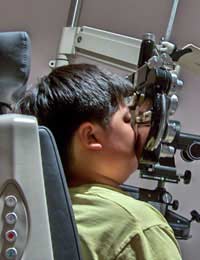Double Vision

If you look at your finger and draw it very close to your eyes you’ll be aware that everything in the background becomes two separate images. This is because your eyes have ‘converged’ for the near object and are not now correctly aligned for viewing at a distance. Double vision, known as diplopia, causes a person to see two images of the same object some or all of the time. Diplopia occurs when the eyes no longer work together as a pair and become out of alignment with each other. This produces two images that the brain is unable to fuse together. This may happen suddenly or over a period of time and sometimes you can get double vision in just one eye.
Double vision can also indicate other underlying, sometimes serious visual disorders that affect children and adults, such as difficulty in converging on near objects or visual conditions caused by head injuries.
If you suddenly experience double vision, for example if you wake up seeing double, you should go immediately to your local casualty department.
The Causes of Double Vision
The most common cause of double vision is misalignment of the two eyes due to functional problems in the visual system, when muscles or nerves may have been weakened or damaged. This condition is referred to as binocular diplopia. About 4% of children under six have signs of binocular diplopia, which is often called a ‘squint’ or a ‘turn’.Double vision can also occur in one eye only (monocular diplopia), due to one or more structural defects in the eye's optical system. The most common cause of monocular diplopia is cataract - a hardening and gradual clouding of the crystalline lens inside the eye which occurs very often in old people. Ageing causes the lens to develop regions where its refractive power varies. These regions may produce separate images on the retina. This form of diplopia may subside with further ageing.
How Double Vision is Treated
The brain of a young child with diplopia learns to suppress the image seen by the weaker, misaligned eye. This needs to be corrected early, usually with glasses or possibly using surgery. If it is left untreated diplopia can lead to poor vision in the affected eye, a condition known as amblyopia (lazy eye). Occlusion (patching) of the better eye may also improve the vision in the lazy eye by making it work. Without treatment amblyopia may become permanent.People with permanent double vision can often be treated using a Fresnel prism - a special transparent plastic sheet which can be trimmed to fit over the lens in a pair of glasses. The Fresnel prism has the effect of displacing the image in the misaligned eye so that it falls where it is supposed to on the retina, allowing the brain to fuse the two images together. If the Fresnel prism is not successful it may be necessary to cover one eye in order to block out one of the double images, at least temporarily
Double vision may gradually disappear with time. If it doesn’t, corrective surgery remains an option.
It’s important to remember that suddenly getting double vision, especially if it has not happened to you before, can indicate more serious conditions such as tumours, cancer or dislocation of the crystalline lens. Don’t ignore it in the hope that it will go away!
- Rosacea in the Eye
- Is a Vitreous Haemorrhage Serious?
- My Mum Has Macular Degeneration
- What is Vitrectomy Surgery?
- Why Do Eyelids Twitch?
- What is Graves' Ophthalmology?
- Retinal Vein Occlusion
- Retinitis Pigmentosa
- Corneal Disease
- Corneal Ulcers
- Nystagmus
- Flashes and Floaters
- Keratoconus
- Eye Infections
- What Causes Dry Eye?
- Diabetes and Eyes
- Hay Fever and Allergies


Re: What is Vitrectomy Surgery?
I had vitrectomy 4 weeks ago. The surgery was not well done as apparently bleeding occurred. The hole did not close despite having…
Re: Glasses or Contacts?
I need a eye exam and new glasses it's been since 2013/ I have no income I lost my boyfriend last September and I've been homeless ever…
Re: Eyewear for the Partially Sighted
This extract from your text is not clear and the grammar is poor- and the letters in the validation box are mixed…
Re: Eye Cancer Symptoms
I have yellow in both eyes lools like 2 dots. But looks like its makin the white part of my eye yellow whats wrong with me
Re: Are my Glasses Affecting my Eyes?
Hi, Please can anyone give advice on wearing varifocals. After a short while I develop a severe ache in my left eye and…
Re: Are my Glasses Affecting my Eyes?
On wearing my new varifocals, I am finding that my left eyeball hurts so much it feels like it will explode after 15…
Re: What is the Cause of my Itchy Eye?
I have One and only One itchy eye that has been going on 24/7 for 5 weeks.Eye is not swollen vision not affected. Eye doc…
Re: Contact Lens Trials Explained
Hi, We wanted to get in touch with you to increase traffic on your website. Please reply to this email so we can send you free…
Re: What Are Photoreceptors?
I have a 10 year old grandson who was diagnosed at apx 2 with cone and rod dystrophy eye disease. Please help with any treatment…
Re: Driving and Eyesight
Danny6520 - Your Question:Hi,I am only 16, but soon I will be 17and I am hoping to drive. However I have a few problems. Firstly, I am…